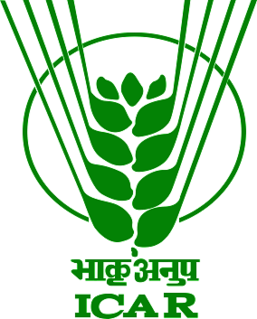Related Research Articles
The following outline is provided as an overview of and topical guide to agriculture:
The following outline is provided as an overview of and topical guide to sustainable agriculture:

Horticulture has been defined as the agriculture of plants, mainly for food, materials, comfort and beauty. According to American horticulturist Liberty Hyde Bailey, "Horticulture is the growing of flowers, fruits and vegetables, and of plants for ornament and fancy." A more precise definition can be given as "The cultivation, processing, and sale of fruits, nuts, vegetables, and ornamental plants as well as many additional services". It also includes plant conservation, landscape restoration, soil management, landscape and garden design, construction and maintenance, and arboriculture. In contrast to agriculture, horticulture does not include large-scale crop production or animal husbandry.

The following outline is provided as an overview of and topical guide to organic gardening and farming:

The Department for Environment, Food and Rural Affairs (Defra) is the government department responsible for environmental protection, food production and standards, agriculture, fisheries and rural communities in the United Kingdom of Great Britain and Northern Ireland. Concordats set out agreed frameworks for co operation, between it and the Scottish Government, Welsh Government and Northern Ireland Executive, which have devolved responsibilities for these matters in their respective nations.
Vegan organic gardening and farming is the organic cultivation and production of food crops and other crops with a minimal amount of exploitation or harm to any animal. Vegan gardening and stock-free farming methods use no animal products or by-products, such as bloodmeal, fish products, bone meal, feces, or other animal-origin matter, because the production of these materials is viewed as either harming animals directly, or being associated with the exploitation and consequent suffering of animals. Some of these materials are by-products of animal husbandry, created during the process of cultivating animals for the production of meat, milk, skins, furs, entertainment, labor, or companionship; the sale of by-products decreases expenses and increases profit for those engaged in animal husbandry, and therefore helps support the animal husbandry industry, an outcome most vegans find unacceptable.

Organic horticulture is the science and art of growing fruits, vegetables, flowers, or ornamental plants by following the essential principles of organic agriculture in soil building and conservation, pest management, and heirloom variety preservation.
NAICS sector 11 is a sub-classification of economic activity that covers agriculture, forestry, fishing and hunting in the North American Industry Classification System (NAICS) system in Canada, the United States and Mexico.

The Indian Council of Agricultural Research (ICAR) is an autonomous body responsible for co-ordinating agricultural education and research in India. It reports to the Department of Agricultural Research and Education, Ministry of Agriculture. The Union Minister of Agriculture serves as its president. It is the largest network of agricultural research and education institutes in the world.

Assam Agricultural University (AAU) is an agricultural education state university which was established in 1969 in Jorhat in the state of Assam, India. The jurisdiction of the University extends to the entire State of Assam with regard to teaching, research and extension education in the field of agriculture and allied sciences. The University has a number of campuses with its headquarters at Borbheta, Jorhat.
This is an alphabetical index of articles related to gardening.
Canada is one of the largest agricultural producers and exporters in the world. As with other developed nations, the proportion of the population and GDP devoted to agriculture fell dramatically over the 20th century but it remains an important element of the Canadian economy. A wide range of agriculture is practised in Canada, from sprawling wheat fields of the prairies to summer produce of the Okanagan valley. In the federal government, overview of Canadian agriculture is the responsibility of the Department of Agriculture and Agri-Food.

Kerala Agricultural University (KAU) is the primary and the principal instrumentality of the Kerala state in providing human resources, and skills and technology, required for the sustainable development of its agriculture, defined broadly encompassing all production activities based on land and water, including crop production (agriculture), forestry and fisheries through conducting, interfacing and integrating education, research and extension in these spheres of economic endeavour. It is situated in Vellanikkara, Thrissur, Kerala. Dr. R. Chandra Babu is the Vice-Chancellor and Dr .S. Leenakumari is the Registrar (i/c)
CSIRO Publishing is an Australian-based science and technology publisher. It publishes books, journals and magazines across a range of scientific disciplines, including agriculture, chemistry, plant and animal sciences, natural history and environmental management. It also produces interactive learning modules for primary school students and provides writing workshops for researchers.

Agriculture in Kenya dominates Kenya's economy. 15–17 percent of Kenya's total land area has sufficient fertility and rainfall to be farmed, and 7–8 percent can be classified as first-class land. In 2006, almost 75 percent of working Kenyans made their living by farming, compared with 80 percent in 1980. About one-half of Kenya's total agricultural output is non-marketed subsistence production.
Indigenous horticulture is practised in various ways across all inhabited continents. Indigenous refers to the native peoples of a given area and horticulture is the practice of small-scale intercropping.

The University of Life Sciences in Lublin is a multi-profile higher education institution, which integrates a wide range of agricultural, biological, veterinary, technical and socioeconomic sciences in Poland. Although the university was established in 1955, its history stems back to 1944 with the creation of the Agrarian and Veterinary Faculties within the new Maria Curie-Skłodowska University (UMCS). In 1955, these two faculties, together with the Faculty of Zootechnics, were spun off to create a new institution, originally called the Lublin Higher School of Agriculture. It was called the Lublin Agricultural Academy from 1972, and took its present name in 2008.

Mitraniketan Vishwavidyapeetam for Open Learning & Total Development is a Non-Governmental organization located at Vellanad, which is 25 km away from Thiruvananthapuram, the capital of Kerala state in South India.It is a 500 member community, including a staff of 100 men and women. Mitraniketan works in the fields of innovation, training and extension in community development, environment, science, education and appropriate technology. The project was begun with a view to offering education and training in a holistic spirit to primarily socially underprivileged children and youngsters. The organization focuses on alternative education mode for development.
National Innovations on Climate Resilient Agriculture (NICRA) was launched during February 2011 by Indian Council of Agricultural Research (ICAR) with the funding from Ministry of Agriculture, Government of India. The mega project has three major objectives of strategic research, technology demonstrations and capacity building. Assessment of the impact of climate change simultaneous with formulation of adaptive strategies is the prime approach under strategic research across all sectors of agriculture, dairying and fisheries. Evolving climate resilient agricultural technologies that would increase farm production and productivity vis-à-vis continuous management of natural and manmade resources constitute an integral part of sustaining agriculture in the era of climate change. The four modules of NICRA – natural resource management, improving soil health, crop production and livestock – is aimed making the farmers self-reliant.

Human uses of living things, including animals plants, fungi, and microbes, take many forms, both practical, such as the production of food and clothing, and symbolic, as in art, mythology, and religion. The skills and practices involved are transmitted by human culture through social learning.
References
- ↑ "Library of Congress Classification Outline: Class S - Agriculture" (PDF). Library of Congress. 2019-04-30. Retrieved 2019-04-30.
- ↑ "Library of Congress Classification Full Text: CLASS S - Agriculture" (PDF). Library of Congress. 2019-05-01. Retrieved 2019-05-01.